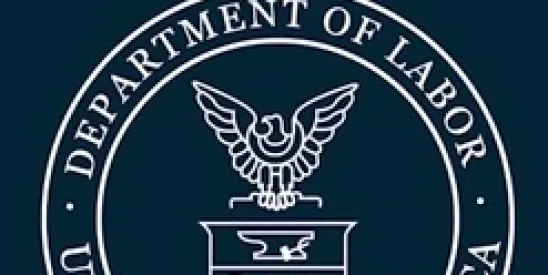On March 24, 2020, the U.S. Department of Labor’s (DOL) Wage and Hour Division issued preliminary guidance for employers and employees concerning the Emergency Family and Medical Leave Expansion Act (EFMLEA) and the Emergency Paid Sick Leave Act (EPSLA). Both laws are part of larger Families First Coronavirus Response Act (FFCRA) enacted on March 18, 2020.
The guidance is provided in three parts: (1) a Fact Sheet for Employees; (2) a Fact Sheet for Employers; and (3) a set of Questions and Answers (Q&As). The trio of documents basically restates the FFCRA in a simpler format. The Q&As do not provide detailed, comprehensive answers to the myriad of employer questions about the FFCRA. However, they do address some critical questions, such as how an employer must count the number of employees to determine coverage; how small businesses can obtain exemptions; how to count hours for eligible employees; and how to calculate the wages that employees are entitled to under the FFCRA. Here are some of the key highlights of the guidance.
Effective Date
“The FFCRA’s paid leave provisions are effective on April 1, 2020, and apply to leave taken between April 1, 2020, and December 31, 2020.”
Covered Employers: 500-Employee Threshold
The EFMLEA and EPSLA cover employers with fewer than 500 employees. To determine coverage, the guidance states that employers should count (1) all employees on any type of leave (e.g., Family and Medical Leave Act [FMLA] leave, vacation leave, sick leave, paid time off, etc.); (2) temporary employees who are jointly employed by one or more employers (regardless of which employer maintains the payroll of these employees; and (3) day laborers supplied by a temporary agency).
The DOL is using the revised joint employer standard under the Fair Labor Standards Act (FLSA) (effective March 16, 2020) to determine whether an entity (including its separate establishments or divisions) will be considered to be a single employer when counting the total number of employees for purposes of EFMLEA and EPSLA coverage. The agency will continue to use the integrated employer standard under the FMLA to assess whether two or more entities are to be treated as a single employer or as separate employers for purposes of counting the number of employees under EFMLEA.
Independent contractors under the FLSA are not considered employees for purposes of the 500-employee threshold.
Small Business Exemption
The EFMLEA and EPSLA both provide exemptions for small businesses with fewer than 50 employees if providing emergency leave and pay would “jeopardize the viability of the business as a going concern.” The DOL, Internal Revenue Service (IRS), and Department of the Treasury issued a joint press release on March 20, 2020, stating that this small business exemption would be enacted, at least as to leave requirements relating to school closings or childcare unavailability, where the requirements would jeopardize the ability of the business to continue. The DOL intends to issue emergency guidance and rulemaking that clearly articulates the standard for this exemption. During the DOL Virtual Town Hall on March 20, 2020, many small businesses requested that the DOL adopt a streamlined process for small businesses to apply for this exemption.
Relaxed Standards for Employee Eligibility Under the EFMLEA
Under the FMLA, eligible employees must have worked 1,250 hours for a covered employer “during the 12 months prior to the start of leave.” Under the EFMLEA, an eligible employee must have been employed for at least 30 calendar days if the employee was on the payroll for the 30 calendar days immediately prior to day the leave would begin. Temporary employees who are subsequently hired by an employer on a full-time basis may count any days they previously worked for the employer toward the 30-day eligibility period.
Interaction Between the EPSLA and EFMLEA
The DOL stated that when paid sick leave and emergency FMLA overlap, as in the childcare situation, they run concurrently (not consecutively) but only for a total of 12 weeks of paid leave. The EPSLA provides for an initial two weeks of paid leave. This period covers the first 10 workdays of expanded family and medical leave (which are otherwise unpaid under the EFMLEA) unless employees elect to use any existing vacation, personal, medical, or sick leave under the employer’s policy. After the first 10 workdays have elapsed, eligible employees will receive 2/3 of their regular rate of pay for the hours they would have been scheduled to work in the subsequent 10 weeks under the EFMLEA. Employees can only receive the additional 10 weeks of expanded leave to care for their children whose schools or places of care are closed, or where the childcare provider is unavailable, due to COVID-19–related reasons.
Retroactivity
The guidance states that the paid leave provisions under the EPSLA and EFMLEA are not retroactive. The guidance states than an employer may not deny paid sick leave to an employee if the employer gave the employee paid leave for a COVID-19 qualifying reason prior to the effective date of the FFCRA.
Grace Period for Compliance
In the March 20, 2020, joint press release by the IRS, DOL, and Department of Treasury, the DOL stated that it would be “issuing a temporary non-enforcement policy that provides a period of time for employers to come into compliance with the Act.” Under this policy, the DOL “will not bring an enforcement action against any employer for violations of [the FFCRA] so long as the employer has acted reasonably and in good faith to comply with the Act.” However, this grace period (1) does not mean that employers may delay compliance with the FFCRA’s provisions; and (2) does not shield employers from liability from private rights of action.
On March 24, 2020, the DOL released a model notice for private employers. In addition, the DOL issued Field Assistance Bulletin No. 2020-1, confirming the DOL’s policy of non-enforcement for violations of the FFCRA “occurring within 30 days of the enactment of the FFCRA, i.e., March 18 through April 17, 2020, provided that [an] employer has made reasonable, good faith efforts to comply with the Act.”
Tax Credits
In the March 20, 2020, joint press release, the IRS offered a preview into the tax credit plan for COVID-19 paid sick leave. The IRS provided the following “key takeaways”:
Complete Coverage
-
Employers will receive 100 percent reimbursement for paid leave provided pursuant to the FFCRA.
-
Health insurance costs will also be included in the credit.
-
Employers will face no payroll tax liability.
-
Self-employed individuals will receive an equivalent credit.
Fast Funds
-
Reimbursement will be quick and easy to obtain.
-
An immediate dollar-for-dollar tax offset against payroll taxes will be provided.
-
Where a refund is owed, the IRS will send the refund as quickly as possible.






 />i
/>i


